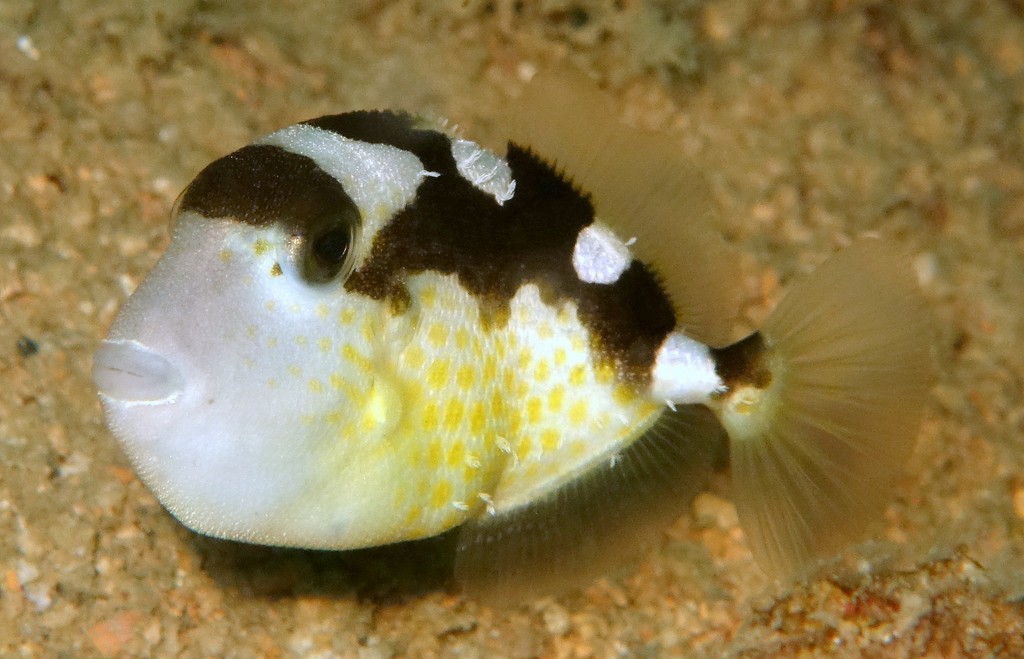ABALISTES STELLATUS - (ANONYMOUS, 1798)
Picture courtesy of: Alain Daoulas
Baliste à trois tâches blanches, Baliste de vase, Flat-tailed Triggerfish, Flat-tailed Trigger-fish, Starry Trigger-fish, Starry triggerfish, Okihagi, オキハギ, 寬尾鱗魨, 宽尾鳞鲀, فریبا ماهی زرد باله,
Etymologie
Abalistes : du préfixe Latin, ab-, abs- = loin de, séparation + du Latin, ballista = lancer, jeter. En référence à la première épine dorsale qui se redresse rapidement quand l'animal est menacé ou quand il chasse. À l'origine, le mot "catapulte" désigne un engin lanceur de flèches, alors que le terme "baliste" fait référence à une machine qui lance des pierres, mais la signification des deux termes a été intervertie à partir du IVe siècle de notre ère, d’où parfois une certaine confusion dans les termes. Le fait que le mot "catapulte" (qui a donné un verbe : "catapulter") soit devenu un terme générique, qui, à certaines époques, désigne indistinctement tous les engins de siège de la baliste au trébuchet, obscurcit encore la terminologie.
stellatus : du Latin, stellatus = étoilé.
Description originale : Balistes stellatus Anonymous, 1798 - Localité type : île Maurice, Mascareignes, sud-ouest de l'Océan Indien.
Synonymes
Balistes phaleratus (Richardson, 1846)
Balistes stellatus (Anonymous, 1798)
Balistes vachellii (Richardson, 1845)
----------------------------------------------
Description
Dorsal spines (total): 3; Dorsal soft rays (total): 25-27; Anal soft rays: 24-25. Body grey brown to olivaceous dorsally with very small pale spots, becoming whitish ventrally with brownish yellow spots many of which anastomose into a reticulum; 3 large oval white spots along the back and a small one dorsally on caudal peduncle; a broad white streak often on side of body posterior to upper end of gill opening. An oblique groove before the eye. Behind gill opening are large osseous scales. Greatest body depth 2-2.5 SL. First dorsal spine 1.6-1.9 HL; 3rd dorsal spine about 1/3 length of first spine. Front of soft dorsal and anal fins not elevated; caudal fin double emarginate, lobes longer with growth. Depressed caudal peduncle, width greater than least depth, very slender and tapering, much longer than deep. Max length: 60.0 cm TL. Depth range: 7 - 350 m.
Etymology
Abalistes: from Latin prefixe, ab-, a-, abs-, au- = away from + from Latin, ballista = to throw, I throw. Referring to the first backbone that rises quickly when the animal is threatened or when hunting. Originally, the word "catapult" refers to an arrow-throwing device, while the term "ballista" refers to a stone-throwing machine, but the meanings of the two terms were reversed from the fourth century AD onwards, leading to some confusion in the terms. The fact that the word "catapult" (which gave rise to a verb: "to catapult") became a generic term, which, at certain times, indiscriminately refers to all siege engines from the ballista to the trebuchet, further obscures the terminology.
stellatus: from Latin, stellatus = starry.
Original description: Balistes stellatus Anonymous, 1798 - Type locality: Mauritius, Mascarenes, southwestern Indian Ocean.
Distribution
Red Sea; Indo-West Pacific: East Africa, South Africa, Persian Gulf, Seychelles, Madagascar and western Mascarenes east to Palau, Fiji and Tonga, north to southern Japan, south to New South Wales (Australia), New Caledonia; Eastern tropical Atlantic.
Biology
Inhabits mud and silt sand bottoms. Adults on deep coastal slopes and usually seen swimming high above the bottom, sometimes found in estuaries. Juveniles in sheltered coastal bays and estuaries with outcrops of rubble or debris on open substrates. Oviparous, distinct pairing during breeding.
Similar species
Abalistes filamentosus (Matsuura & Yoshino, 2004) - Reported from New Caledonia. Link to the species (here).
Abalistes stellaris (Bloch & Schneider, 1801) - In Taxonomy and systematics of tetraodontiform fishes 2014 - Keiichi Matsuura - Ichthyological Research January 2015, Volume 62, Issue 1, pp 72–113 : "Matsuura and Yoshino (2004) studied the monotypic genus Abalistes and recognized two species, Abalistes stellatus (Anonymous, 1798) and a new species, Abalistes filamentosus (Matsuura & Yoshino, 2004).
Original description: Balistes stellatus Anonymous, 1798 - Type locality: Mauritius, Mascarenes, southwestern Indian Ocean.
Distribution
Red Sea; Indo-West Pacific: East Africa, South Africa, Persian Gulf, Seychelles, Madagascar and western Mascarenes east to Palau, Fiji and Tonga, north to southern Japan, south to New South Wales (Australia), New Caledonia; Eastern tropical Atlantic.
Biology
Inhabits mud and silt sand bottoms. Adults on deep coastal slopes and usually seen swimming high above the bottom, sometimes found in estuaries. Juveniles in sheltered coastal bays and estuaries with outcrops of rubble or debris on open substrates. Oviparous, distinct pairing during breeding.
Similar species
Abalistes filamentosus (Matsuura & Yoshino, 2004) - Reported from New Caledonia. Link to the species (here).
Abalistes stellaris (Bloch & Schneider, 1801) - In Taxonomy and systematics of tetraodontiform fishes 2014 - Keiichi Matsuura - Ichthyological Research January 2015, Volume 62, Issue 1, pp 72–113 : "Matsuura and Yoshino (2004) studied the monotypic genus Abalistes and recognized two species, Abalistes stellatus (Anonymous, 1798) and a new species, Abalistes filamentosus (Matsuura & Yoshino, 2004).
Pseudobalistes fuscus (Bloch & Schneider, 1801) - Reported from New Caledonia - Link to the species (here). Juveniles are similar.
